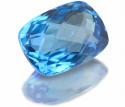December: Blue Topaz
December Birthstone: Blue Topaz
Birthstone Color: Light to Dark Blue
 Blue Topaz Myths & Historical Facts
Blue Topaz Myths & Historical Facts
December’s birthstone is the blue topaz. It is derived from the Sanskrit word “tapas”, meaning fire. Blue topaz was considered to have cooling properties by ancient civilizations. They believed that throwing a blue topaz into a pot of boiling water would cool the water. It was also believed that the stone to calm hot tempers! This gemstone has been credited with many other healing powers; ability to cure insanity, asthma, weak vision and insomnia.
Blue topaz is the hardest of the silicate mineral. Pure topaz is colorless, minor changes of elements within the stone can result in a variety of other colors such as; blue, pale green, red, yellow, and pink. The blue topaz is created when the stone is heated. There are three shades of blue topaz; Sky, Swiss, and
A gift of Blue Topaz is symbolic of love and fidelity.
Alternate Birthstone
An alternate birthstone for December is the Tanzanite. Tanzanite ranges from blue to purple. Its depth of hue and purity of color is unmatched by most gems.
Tanzaniteis found in the shadows of the majestic Mount Kilimanjaro in Tanzania, the only commercial source for the gemstone. In 1967, an Indian tailor prospecting for gems as a hobby discovered the gem. It was eventually named tanzanite in honor of its country of origin. The gem is often described as “velvety,” mostly because of its deep and saturated color, which ranges from purplish blue to a pure blue.
Tanzanite Facts:
-Tanzanite is a variety of the mineral species called zoisite.
-Some rare gem zoisites may be brown, pink, or green.
-Tanzanite has a hardness of 6.0-7.0 on the Mohs Hardness Scale.
-Some tanzanites are carved or sculpted by famous lapidary artist.
-It is only found in one place on earth, Tanzania.
Tanzanite Treatment:
Most tanzanite is routinely heat treated, which causes a change of color in the rough material from brown, purple or grey to a deep blue, blue-purple or purple-blue. Information about any stone known to be treated should be disclosed to the buyer.
Synthetic Tanzanite:
There are no manufacturers of man-made tanzanite, though convincing simulates exist. That means that while a stimulant looks like tanzanite, it does not share the same chemical, physical or optical characteristics.
Tanzanite Care and Cleaning:
-Tanzanites are somewhat delicate and should be worn with care.
-To minimize scratching and wear, store each piece of fine jewelry separately in a soft cloth of padded container.
-Tanzanites should never be put in an ultrasonic cleaner or steam-cleaned.
-The safest way to clean tanzanite jewelry is to use warm, sudsy water and a tightly woven micro fiber or other soft cloth.
-Take all your fine jewelry to a professional jeweler at least twice a year for a thorough cleaning and inspection.

